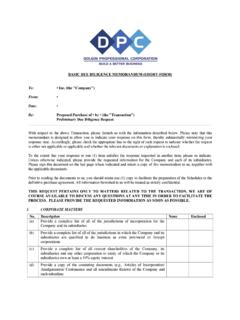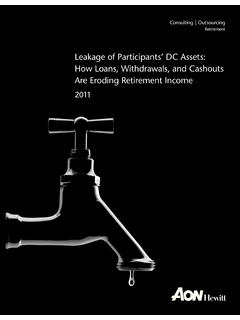Transcription of BEYOND THE CHECKLIST: THINKING YOUR WAY …
1 BEYOND THE CHECKLIST: THINKING your WAY through SHAREHOLDER AGREEMENTS Overview BEYOND the Checklist (Handout) o How to Approach the Process - General Principles o THINKING your Way through Key Substantive Areas o THINKING your Way through Key Practical Considerations Ten (10) Key General Principles Think of shareholder agreements as a relationship management tool (akin to a product operating manual); [in fact all legal contracts and agreements are really just one form of relationship management tool whether long term or single event relationships] Everything has a beginning, middle & end and it is easier to provide for the end at the outset Need to balance three (3) things: (a) forecasting of future relevant scenarios ( , what can happen?), (b) probability theory ( , is it likely to happen?) and (c) relevancy/practicality ( , do we need to go there for this particular client?)
2 Consider if the parties need (or are ready for) a comprehensive vs. special purpose shareholder agreement Focus should be on achieving the parties needs in two (2) key areas: control & liquidity Consider if you need an ordinary shareholder agreement or whether a formal unanimous shareholder agreement ( , USA ) is necessary , an agreement among all of the shareholders under which all (or part) of the powers, liabilities and defences of the directors are removed and granted to the shareholders ; consider the extent to which the shareholders need to restrict, in whole or in part, the powers of the directors to manage the business and affairs of the corporation ; Historical Note: USA was created by the legislatures because certain matters were only within the exclusive authority of the directors and the directors were not permitted to enter into an agreement that fettered their discretion to manage the corporation 2 Consider dual interests of the corporation + the principals , initial moratorium/standstill on certain key mechanisms to allow the corporation to grow/mature and accrue value ( , shotguns and dividends/distributions) Remember that shareholders are (often) employees and an integrated approach is essential in considering departure scenarios Planning and customization are very important the only way to properly customize is to ask good questions in essential (and sometimes esoteric) areas so to facilitate (a) the forecasting of probable & relevant future scenarios and (b)
3 The negotiation of reasonable and fair outcomes Focus on both substantive and procedural aspects , the benefit of the right substantive mechanism ( , shot-gun) can get lost if the procedural rules are not properly drafted ( , are there multi-party considerations? are shares and debt addressed? are all classes of shares addressed? what are the consequences for default? are narrow or broad non-price terms permitted?) Eleven (11)_Key Substantive Areas REMEMBER TO FOCUS ON CONTROL + LIQUIDITY Elements of Control 3 Levels to Consider o Day-to-Day Management will the identity of the officers be fixed by agreement or left to the board to determine from time to time employment agreements are helpful consider job descriptions and areas of autonomy vs. collaboration this is critical where there is no majority shareholder otherwise nothing will get done as all shareholders will feel entitled to be consulted on all decisions (big & small) o Board of Directors consider an appropriate board size should all shareholders serve as directors?
4 How to avoid board deadlocks - role of independent directors - avoid even number of directors - casting votes for chairman - rotating chairman 3 board meeting quorums what is the threshold and is any particular director required to attend to constitute a quorum? board nomination rights are they permanent or can they be lost/changed? can anyone be nominated or only a qualified person? statutory responsibility to supervise management statutory power to: - declare dividends - issue shares - redeem/repurchase shares - approve all actions outside ordinary course of business o Shareholder Veto Rights ( , de facto control) majority vs. minority power balance USA considerations and potential shareholder liability issues; essentially if you don t want a holdco or family trust to have director/managerial level liability then you do not want to create a USA and ensure the shareholder agreement retains a fully functioning board and does not remove any usual board decisions or managerial oversight which might attract liability; need to be very careful in this area as an unwary shareholder with a significant balance sheet could find itself subject to liability where none was intended; need to ensure passive shareholders with large balance sheets do not participate in decision making (except to the extent necessary) impact on CCPC status are they permanent or can they be lost/changed?
5 Laundry list vs. targeted approach typical laundry list would include ability to control: - changes in board size - share issuances/redemptions/repurchases - amendments to articles/bylaws - establishment of subsidiaries - mergers, amalgamations or business combinations - asset encumbrances out of the ordinary course - borrowing money out of the ordinary course - financial assistance/guarantees to others - payment of dividend/other distributions - approval of operating/capital budgets - capital expenditures exceeding approved budgets - disposition of assets out of the ordinary course 4 - changes in nature of business - dissolution/bankruptcy/windup - changes in compensation for key employees - changes in employment terms for key employees - execution of key contracts/agreements - entering into of non-arm s length arrangements - changes in accounting firm/legal counsel - changes in fiscal year end - changes in registered head office - any other fundamental change o Voting Agreements/Voting Trusts when might you need these are veto rights sufficient or not?
6 Is a class of non-voting shares preferred? o Shareholder Meetings shareholder meeting quorums what is the threshold and is any particular shareholder required to attend to constitute a quorum? Liquidity o event-based vs. ordinary course o who controls liquidity affected or unaffected parties? o who is the buyer is key in terms of flow of funding and taxation of the proceeds in the hands of the seller o event-based or time-based breach/default of agreement ( , passive vs. active role) family law events - understand case law - understand choice of instruments to address issue - call option most suitable given actual risk - early vs. late application of call option insolvency - why should you care? - avoid sweetheart deals which may not be enforced if pricing/payment terms are off market disability 5 - what is suitable definition of disability - should it matter with passive shareholders ?
7 Termination of employment - reason for termination may impact pricing and payment terms death - consideration of tax implications is essential - optional vs. mandatory - who controls process survivors or deceased s estate? - timeline and use of insurance to fund - valuation FMV or pre-determined at fixed amount - is liquidity/sale really necessary or desirable? - can surviving shareholders live with deceased s estate under existing (or amended) shareholder agreement ? other , time-based targeted puts and calls designed to give a strategic shareholder a pre-determined future exit o ordinary course shot-gun/auction process - consider moratorium/standstill to allow corporate value to accrue - assume it will be used strategically so consider balance of power issues - if you really have a natural buyer and natural seller then a shot-gun (while fair on paper) may not work in reality - remember - recipient of shot-gun holds all power - don t underestimate - shot-guns can produce surprising results - consider penalty for failure to comply and appropriate closing procedures - impact on employment and termination costs resignation or not?
8 - consider rigid shot-gun where all terms (but price) are predetermined vs. flexible/creative shot-gun where anything goes (but price and terms inconsistent with the agreement , non-compete) - consider appropriate response time and deeming provision where fail to respond rights of first refusal/opportunity - restrictions on selling to competitors - minimum purchase requirements and time to respond - deeming provision where fail to respond - purchaser subject to terms of shareholder agreement 6 - ability to match non-cash consideration with cash if applicable - preference towards first rights of opportunity vs. first refusal rights (unless coupled with a break-up fee) as the latter do not provide 3rd parties with appropriate incentives to negotiate a deal piggyback/tag-along rights - permits pro-rata exit by all shareholders drag-along rights - consider moratorium/standstill - what is appropriate approval threshold o permitted transfers without consent controlled holdcos, family trusts and/or specific immediate family members consider transfers among existing shareholders ( , create an internal market for shares) remember need to manage ownership and control of any upstream shareholders ( , holdcos/trusts)
9 As changes upstream can adversely impact the target corporation o closing considerations on share sales between shareholders security for unpaid purchase price interest on unpaid purchase price acceleration of unpaid purchase price repayment of shareholders loans due to/due from release of personal guarantees default provisions where a party fails to attend closing Amending & Terminating Powers o unanimous approval or lesser threshold o typically unanimous in cases of a small number of active shareholders vs. lesser threshold with a larger number of passive shareholders o cherry-picking approach , substantive amendments require 100% approval vs. housekeeping amendments which require lesser threshold Signing Authorities 7 o consider both contracts & cheques o need to provide flexibility o board vs. shareholder approval to amend Financing o equity financing and pre-emptive/anti-dilution rights (OBCA vs.)
10 CBCA) o bank debt o personal guarantees & contribution/proportional liability o capital calls and consequences of breach Corporate Distributions o is a moratorium/standstill appropriate? o consider ordering , should loans be repaid before dividends are declared? o what approval threshold is required before distributions can be effected? Financial Reporting/Disclosure o corporate law minimum standards are likely insufficient o consider frequency and quality of financial, budgetary and planning report and access to financial and other information by directors and shareholders o are different standards necessary for active vs. passive shareholders o what is practical? what is cost-effective? Confidentiality, Restrictive Covenants and Ownership of IP/Work Product o basic provisions can also be part of employment agreement but be careful to avoid conflicting provisions o confidentiality essential for trade secrets o migration of ownership of work product from individuals to the corporation essential to creating/growing enterprise value o restrictive covenants must be reasonable in scope (time/geography) to be enforceable 8 o consider both non-solicitation and non-competition restriction following departure of a shareholder Pricing & Payment terms o should price penalties apply ( , default or cause termination)?








